Cherub
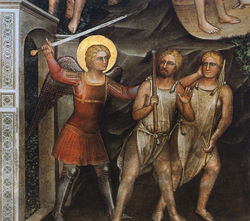
Cherubim (Heb. כרוב, pl. כרובים, eng. trans kruv, pl. kruvim, dual kruvayim lat. cherub[us], pl cherubi[m]) are divine beings in the Bible. The plural can be written as cherubim or cherubs. In modern English the word is usually used for what are strictly putti, baby or toddler angels in art. This article is concerned with the original sense of the word.
Cherubs are mentioned in the Torah (five books of Moses), the Book of Ezekiel, and the Book of Isaiah. They are also mentioned in the books of 1 Kings, 2 Kings, 1 Chronicles, and 2 Chronicles mainly in the construction of the House of God.The prophet Ezekiel describes them as a tetrad of living creatures, each having four faces: of a lion, an ox, an eagle (or griffon vulture [1]), and a man. They are said to have the stature and hands of a man, the feet of a calf, and four wings. Two of the wings extended upward, meeting above and sustaining the throne of God; while the other two stretched downward and covered the creatures themselves. In the Christian New Testament Cherubs are mentioned in the Book of Revelation.
Contents |
Origins
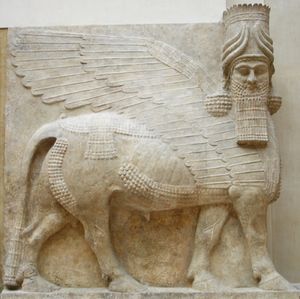
The term cherubim is cognate with the Assyrian term karabu, Akkadian term kuribu, and Babylonian term karabu; the Assyrian term means 'great, mighty', but the Akkadian and Babylonian cognates mean 'propitious, blessed'.[2][3] In some regions the Assyro-Babylonian term came to refer in particular to spirits which served the gods, in particular to the shedu (human-headed winged bulls);[4] the Assyrians sometimes referred to these as kirubu, a term grammatically related to karabu.[2] They were originally a version of the shedu, protective deities sometimes found as pairs of colossal statues either side of objects to be protected, such as doorways.[5][6] However, although the shedu were popular in Mesopotamia, archaeological remains from the Levant suggest that they were quite rare in the immediate vicinity of the Israelites.[7] The related Lammasu (human-headed winged lions — to which the sphinx is similar in appearance), on the other hand, were the most popular winged-creature in Phoenician art, and so most scholars suspect that Cherubim were originally a form of Lammasu.[8] In particular, in a scene reminiscent of Ezekiel's dream, the Megiddo Ivories — ivory carvings found at Megiddo (which became a major Israelite city) — depict an unknown king being carried on his throne by hybrid winged-creatures.[9]
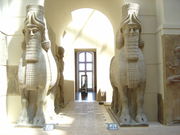
The Lammasu was originally depicted as having a king's head, a lion's body, and an eagle's wings, but due to the artistic beauty of the wings, these rapidly became the most prominent part in imagery ;[2] wings later came to be bestowed on men, thus forming the stereotypical image of an angel.[10] The griffin — a similar creature but with an eagle's head rather than that of a king — has also been proposed as an origin, arising in Israelite culture as a result of Hittite usage of griffins (rather than being depicted as aggressive beasts, Hittite depictions show them seated calmly, as if guarding),[11] and a few scholars have proposed that griffin may be cognate to cherubim, but Lammasu were significantly more important in Levantine culture, and thus more likely to be the origin.[2]
Early Semitic tradition conceived the cherubim as guardians, being devoid of human feelings, and holding a duty both to represent the gods and to guard sanctuaries from intruders, in a comparable way to an account found on Tablet 9 of the inscriptions found at Nimrud.[2] In this view, cherubim, like the shedu, were probably originally depictions of storm deities, especially the storm winds.[12] This view is offered as a hypothesis to explain the reason for cherubim being described as acting as the chariot of Yahweh in Ezekiel's dream, the Books of Samuel,[13] the parallel passages in the later Book of Chronicles,[14] and passages in the early Psalms[2]: "and he rode upon a cherub and did fly: and he was seen upon the wings of the wind".[15][16]
Post-biblical Judaism
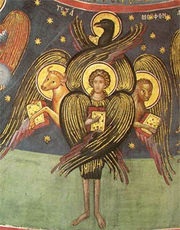
Judaism includes belief in the existence of angels, including Cherubim within the Jewish angelic hierarchy. The existences of angels is generally not contested within rabbinic Judaism; there is, however, a wide range of views on what angels actually are, and how literally one should interpret biblical passages associated with them.
In Kabbalah there has long been a strong belief in Cherubim, with the Cherubim, and other angels, regarded as having mystical roles. The Zohar, a highly significant collection of books in Jewish mysticism, states that the Cherubim were led by one of their number, named Kerubiel.[2]
On the other end of the philosophical spectrum is the view of Rabbi Moshe ben Maimon, better known as Maimonides. He had a neo-Aristotelian interpretation of the Bible. Maimonides writes that to the wise man, one sees that what the Bible and Talmud refer to as "angels" are actually allusions for the various laws of nature; they are the principles by which the physical universe operates. "Guide of the Perplexed" II:4 and II:6.
- For all forces are angels! How blind, how perniciously blind are the naive?! If you told someone who purports to be a sage of Israel that the Deity sends an angel who enters a woman's womb and there forms an embryo, he would think this a miracle and accept it as a mark of the majesty and power of the Deity - despite the fact that he believes an angel to be a body of fire one third the size of the entire world. All this, he thinks, is possible for God. But if you tell him that God placed in the sperm the power of forming and demarcating these organs, and that this is the angel, or that all forms are produced by the Active Intellect - that here is the angel, the "vice-regent of the world" constantly mentioned by the sages - then he will recoil.
- For he {the naive person} does not understand that the true majesty and power are in the bringing into being of forces which are active in a thing although they cannot be perceived by the senses....Thus the Sages reveal to the aware that the imaginative faculty is also called an angel; and the mind is called a cherub. How beautiful this will appear to the sophisticated mind - and how disturbing to the primitive."
Maimonides says (Guide for the Perplexed III:45) that the figures of the cherubayim were placed in the sanctuary only to preserve among the people the belief in angels, there being two in order that the people might not be led to believe that they were the image of God.
Reform Judaism and Reconstructionist Judaism generally either drop references to angels or interpret them metaphorically.
Cherubs are discussed within the midrash literature. The two cherubayim placed by God at the entrance of paradise (Gen. iii. 24) were angels created on the third day, and therefore they had no definite shape; appearing either as men or women, or as spirits or angelic beings (Genesis Rabbah xxi., end). The cherubim were the first objects created in the universe (Tanna debe Eliyahu R., i. beginning). The following sentence of the Midrash is characteristic: "When a man sleeps, the body tells to the neshamah (soul) what it has done during the day; the neshamah then reports it to the nefesh (spirit), the nefesh to the angel, the angel to the cherub, and the cherub to the seraph, who then brings it before God (Leviticus Rabbah xxii.; Eccl. Rabbah x. 20).
A midrash states that when Pharaoh pursued Israel at the Red Sea, God took a cherub from the wheels of His throne and flew to the spot, for God inspects the heavenly worlds while sitting on a cherub. The cherub, however, is "something not material", and is carried by God, not vice versa (Midr. Teh. xviii. 15; Canticles Rabbah i. 9).
In the passages of the Talmud that describe the heavens and their inhabitants, the seraphim, ofannim, and ḥayyot are mentioned, but not the cherubim (Ḥag. 12b); and the ancient liturgy also mentions only these three classes.
In the Talmud, Yose ha-Gelili holds,[17] when the Birkat HaMazon (Grace after Meals) is recited by at least ten thousand seated at one meal, a special blessing - "Blessed is Ha-Shem our God, the God of Israel, who dwells between the Cherubim" - is added to the regular liturgy.
Christianity
In Catholic theology, following the writings of Pseudo-Dionysius, the cherubim are the second highest rank in the angelic hierarchy, following the Seraphim.[18] In western art, Putti are sometimes mistaken for Cherubim, although they look nothing alike.
Depictions
There were no cherubim in Herodian reconstruction of the Temple, but according to some authorities, its walls were painted with figures of cherubim.[19] In Christian art they are often represented with the faces of a lion, ox, eagle, and man peering out from the center of an array of four wings (Ezekiel 1:5-11, 10:12,21 Revelation 4:8); (seraphim have six); the most frequently encountered descriptor applied to cherubim in Christianity is many-eyed, and in depictions the wings are often shown covered with a multitude of eyes (showing them to be all seeing beings). Since the Renaissance, in Western Christianity cherubim have become confused with putti—innocent souls, looking liked winged children, that sing praises to God daily—that can be seen in innumerable church frescoes and in the work of painters such as Raphael.
See also
- Cupid and Kama
- Cherubism (medical condition)
- CHERUB (children's book series)
- CHERUBS (birth defect organization)
- Hierarchy of Angels
- Putto
References
- ↑ Genesis 3:24 (King James Version) at Bible Gateway.com
- ↑ 2.0 2.1 2.2 2.3 2.4 2.5 2.6 Jewish Encyclopedia
- ↑ De Vaux, Roland (tr. John McHugh), Ancient Israel: Its Life and Institutions (NY, McGraw-Hill, 1961)
- ↑ ibid
- ↑ ibid
- ↑ Peake's commentary on the Bible
- ↑ ibid
- ↑ ibid
- ↑ Wright, G. Ernest, Biblical Archaeology (Philadelphia, Westminster Press, 1957)
- ↑ ibid
- ↑ ibid
- ↑ ibid
- ↑ 1 Samuel 4:4, 2 Samuel 6:2, 2 Samuel 22:11
- ↑ 1 Chronicles 13:6
- ↑ 2 Samuel 22:11
- ↑ Psalms 18:10
- ↑ Berakhot 49b
- ↑ Dionysius the Areopagite's Celestial Hierarchy - See Chapter VII
- ↑ Yoma 54a
Further reading
- Yaniv, Bracha, The Cherubim on Torah Ark Valances, Jewish Art Department, Bar-Ilan University, published in Assaph: Studies in Art History, Vol.4, 1999
External links
- Judaism FAQs: What about angels, demons, miracles, and the supernatural?
- Jewish Encyclopedia: Cherub
- Catholic Encyclopedia: Cherubim
- The Cherubim - some pointers and problems by Rabbi Dr Raymond Apple
| First Sphere (liberated) |
Seraphim • Cherubim • Thrones |
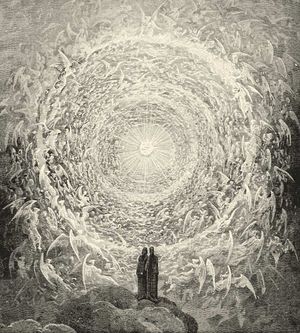 |
|---|---|---|
| Second Sphere (active) |
Dominions • Virtues • Powers |
|
| Third Sphere (active) |
Principalities • Archangels • Angels |
|